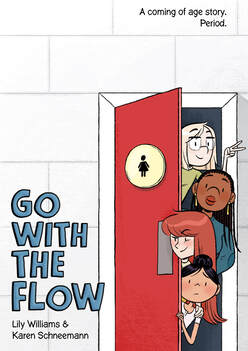 ~Review by Amanda Smith Go with the Flow (First Second, 2020) is written and illustrated by Lily Williams and Karen Schneemann, co-creators of the online comic series The Mean Magenta and is the book I wish I had when I was a teen. Brit, Sasha, Christine and Abby are four sophomore friends, who share laughs, rides, cookies and quiet conversations about their struggles with their periods. These four girls could not be more different in ethnicity, body types, personalities, and menstrual experiences, which makes this book super relatable to its YA audience. (No one-note, perfect, fictional girls here!) Upbeat Abby, fierce defender of women’s rights, decides to address the lack of feminine products in their school’s bathrooms after Sasha has a period emergency. Her passion and determination to be heard leads to hurt feelings, teetering friendships, and important lessons about listening. Brit deals with excruciating cramps that forces her to miss several days of school per month. She has to face well-meaning but clueless male teachers, and experiences anxiety about what might be wrong with her. Go with the Flow also addresses other teenage topics such as boys (the nice ones and the “fart bags”), sexual identity, generational and cultural gaps, activism, and kindness, without ever being preachy. This YA graphic novel, filled with interesting facts throughout and containing oodles of relevant backmatter, is geared towards a more mature audience. However, it is a must-read, helping teens feel more comfortable about their changing bodies, and opening their eyes to what peers might be experiencing. Readers will recognize themselves within these pages, and all the characters will inspire them to be their best selves. On Writing: Bravo for bravery! Lily and Karen unabashedly tackle a subject that has been dubbed as “inappropriate” and “gross” for generations. In Abby’s words “you know, the patriarchy, and all that (barf)”. They deliver a plot focused on the menstrual cycle with lots of heart and tons of humor. They give the reader relatable characters, who feel as real as flesh-and-blood friends. They sprinkle thought-provoking ideas and acts of kindness throughout, educating and arming their readers with knowledge, courage, and hope. If you are feeling hesitant about your own work in progress with “taboo” themes, study Go With the Flow for a dose of daring. Browse the original Mean Magenta comics here: themeanmagenta.com/ Learn more about Karen at www.karenschneemann.com/ To learn more about Lily, visit lilywilliamsart.com/
0 Comments
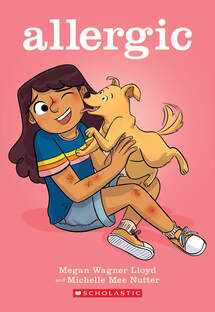 ~ Review by Amanda Smith The only thing Maggie wants for her birthday is a puppy. Her twin brothers have one another to play with and her parents are busy preparing for the new baby. Maggie knows her very own dog will be her best friend. But when she finds the perfect puppy at the shelter, she also finds out she is allergic to dogs. Extremely, land-in-the-hospital allergic. To any animal with fur or feathers. Maggie often feels excluded and jealous of friends who can have pets. She feels guilty because her classroom hamster had to move to a different class due of her allergies. Even though she is getting allergy shots, the process is long and does not offer immediate relief. Her friend Claire, who doesn’t really understand the seriousness of Maggie’s allergies, tries to help, and her solution leads to even more problems and heartache. Throughout Allergic (Graphix, 2021), Maggie learns the challenges and limitations of living with allergies. But she also learns to be a better big sister, and that she is very much needed, wanted, and loved as part of her family. Allergic gives a voice to children dealing with allergies, or help them understand friends with allergies. Many allergy sufferers feel, like Maggie, helpless, and are sometimes left out because of something completely outside their control. Without being didactic, Allergic explores these emotional challenges, along with themes of friendship, family, and what it means to belong. On Writing: The graphic novel format is the perfect vehicle for this story. Intertwining visual and written storytelling, Lloyd and Nutter delivers the scientific and medical information in bite-size pieces that are interesting and relatable to young readers. Through a combination of art and text, reoccurring themes are strengthened. ALLERGIC is a great study of the dance between illustration and words, even in books for older readers, and how both these aspects enhance story-telling. To learn more about Megan Wagner Lloyd visit meganwagnerlloyd.com/. You can find more of Michelle's fabulous art at michellemee.com/. 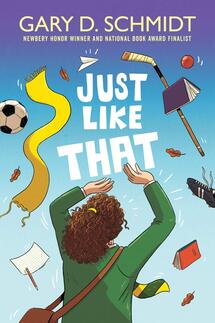 Review by Amanda Smith Gary Schmidt did it again! As in Ok For Now, Just Like That (HMH, 2021) takes place directly after The Wednesday Wars and follows a minor character from the Newbury Honor novel in their own coming of age story. Meryl Lee Kowalski, Holling Hoodhood’s best friend, is sent to a Maine boarding school after a devastating personal loss. Surrounded by shallow, spoiled girls, strict teachers blinded by tradition and decorum, and disturbing news from the war in Vietnam, Meryl Lee battles to keep the Blank at bay. But she also makes friends: Heidi with her hockey sticks; Mousy Marian (who learns to roar); and Bettey, a local girl employed by the school as serving staff. And Matt Coffin, the boy whose eyes tell Meryl Lee that he knows the Blank too. And then there is Dr. Nora MacKnockater, headmistress of St. Elene Preparatory Academy for Girls, who inspires Meryl Lee with her assembly speech on the first day of school. There will be Obstacles, Dr MacKnockater said, but the girls should have Resolve. And then they will grow Accomplished. Dr. MacKnockater who can focus her searchlight eyes on Meryl Lee as if she can spot the Blank when it attempts to overcome Meryl Lee. Dr. MacKnockater who takes Matt Coffin in from the streets and helps him face his own dark past when he cannot run from it anymore. Individually and together, under the protection and wisdom of Dr. MacKnockater, Meryl Lee and Matt resolve to overcome obstacles and challenge the status quo. The reader is swept along on their captivating journey to becoming increasingly Accomplished as they banish the Blank. ON WRITING: There is always so much to learn from a Gary Schmidt novel. One can get all wrapped up in his beautiful language use and unique turn of phrase. But more than anything else, Schmidt is a master at creating a rich and layered reading experience. In this novel, he adds layers through different devices: Just as in The Wednesday Wars and OK for Now, he uses classic literary works to emphasize character traits and showcase character development. For example, Meryl Lee draws parallels from The Wizard of Oz to her own life, while Matt dubs Dr. MacKnockater Bagheera after she reads The Jungle Book to him. As another layer, Schmidt solidifies setting by weaving paraphrased song lyrics from the sixties through the novel in a delightfully sweet and original way. Clever repetition, both in close proximity to emphasize emotion or heighten tension, as well as throughout the novel to bring deeper understanding, adds to the layers. He also uses capitalization of abstract concepts, such as resolve, to make them concrete and real, and give them presence. And he sprinkles in unexpected moments of laugh-out-loud humor to lighten the heaviness in both Meryl Lee and Matt’s stories. All of these layers lead to a tight narrative and a truly satisfying read. Learn more about Gary Schmidt and his books here. 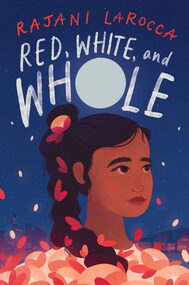 ~Review by Amanda Smith Red, White, and Whole by Rajani LaRocca is a touching novel in verse about Reha, a first-generation Indian American girl who comes to terms with living in two worlds. As an immigrant and mother of first-generation American children, this novel truly resonated with me. Even though our countries of origin are different, LaRocca touches on universal immigrant experiences such as missing extended family and always feeling a little different or other. But Red, White, and Whole isn’t just about the immigrant experience. It is a tender look at mother-daughter relationships, and it is a beautiful coming of age story as Reha faces the unimaginable: her mother's battle with Leukemia. LaRocca entwines Indian folklore into the narrative to add another layer to her poignant storytelling and character development. Subtle repetition of key phrases and the calculating use of “red” and “white” throughout the novel bind the individual poems together – and the result is synergy: a WHOLE that is greater than the sum of its parts. On Writing: LaRocca supports the main theme of "two worlds" with recurring images of the colors red and white, and how they relate to the parts of blood, as well as virtue and grief in Indian culture. Red, White and Whole is a study in repetition within a verse novel. LaRocca weaves threads and themes seamlessly throughout, often when the meaning of the phrases are altered by context or circumstances. The similarity of the words paired with the difference in context delivers a forceful emotional punch. To learn more about Rajani, visit her website at www.rajanilarocca.com/ 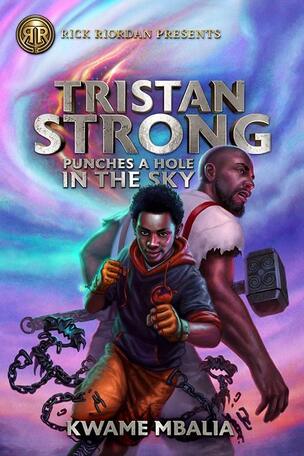 ~Reviewed by Amanda Smith “You control the story, you control the narrative, you control the power.” – High John Tristan Strong carries a lot of stories with him. The stories of his father and grandfather’s boxing success, compared to his first-match failure. Or the story of how his best friend, Eddie died in a bus accident, while he survived. The folk lore and African mythology his nana had told him. The journal in which Eddie collected those stories. So, when a sticky little doll baby appears in Tristan room at his grandparents’ house in Alabama, squelches its way across the floor and nabs Eddie’s journal, Tristan fights hard to retrieve it. In the fight with Gum Baby, he punches a hole in the fabric that separates our world from the realm where folk heroes are gods of Midpass and African gods rule Alke. On his epic hero’s journey to stop the destruction caused by his punch, he meets a fascinating cast of gods, heroes, and villains. He travels to amazing cities; fights alongside fierce warriors; meets the pain of his past head-on; and discovers the strength of story and his power as Anansesem (magical storyteller) to wield it. He learns the rip between Midpass and Alke existed long before his careless fist caused the tear in the sky, and healing lies in telling all the stories of the past – even the painful ones. TRISTAN STRONG PUNCHES A HOLE IN THE SKY (Rick Riordan Presents, Disney.Hyperion 2019) is Kwame Mbalia's powerful debut novel and Coretta Scott King honors recipient. It tells not only Tristan’s story, but also, through symbolism, the history of slavery and the Middle Passage. Bringing often untold African-American history, alongside West African Mythology adds a fascinating, educational and important layer to this novel. While one could read the novel as pure entertainment, I often paused my reading to research a character or name, and discovered deeper meaning. And some of the history on which Mbalai touches directly connects with current conversations around systemic racism. However, the novel is never dull or didactic. Mbalai delivers mythology and history with huge doses of humor, Marvell-movie-like fast-paced-action, lovable characters, authentic dialogue, goosebump-inducing place-descriptions, and the most beautiful magic scene I have ever read. Mbalia’s use of language is decadent: smuggled in bits of internal rhyme, dashes of alliteration, sensational imagery, clever humor, and masterful never-forced use of dialect. Tristan Strong might be an Anansesem, but the true story weaver here is Kwame Mbalia! On Writing: Even though the entire novel is a perfect mentor text for use of language in world building, I was truly struck by the tightness of the first chapter, and would highly recommend it as a study in beginnings. At the end of page fourteen, internal and external conflict have been established, we know Tristan’s shame and struggles, names of African gods have been introduced, we have a mysteriously knowing Nana, and a strangely glowing journal that keeps showing up in unexpected places. As Tristan Strong stated, “I mean really, what could go wrong?” The sequel, TRISTAN STRONG DESTROYS THE WORLD will release October 6, 2020. I can hardly wait to revisit these characters and this world! To learn more about Kwame Mbalia visit https://kwamembalia.com/ 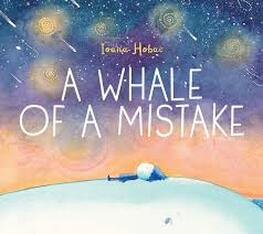 ~ Reviewed by Amanda Smith A WHALE OF A MISTAKE by Ioana Hobai (Page Street Kids, 2020) is a picture book about how anxiety can inflate a mistake to colossal proportions. The story gently conveys how to find perspective and regain control. The protagonist makes a mistake which grows into a whale that swallows the protagonist and takes it out to sea. Along this wild ride, the protagonist feels trapped, powerless, and scared, but through observation and self-reflection, learns and grows, and eventually becomes brave enough to move on. Hobai cleverly uses the whale, something concrete that young children can comprehend, as a metaphor for abstract, hard to pin-point emotions of guilt, anxiety and self-doubt. The watercolor illustrations bring the whale metaphor to life, and enhances the emotions through tumultuous swirls and stormy washes. The color story moves from dark bruise-like colors in the beginning towards light, bright and cheerful colors towards the end, reinforcing the emotional journey. A WHALE OF A MISTAKE is written in simple language, making it easily accessible to young readers, yet the content is universal which makes this a great conversation starter for readers of any age regarding regret and self-reflection. ON WRITING: A WHALE OF A MISTAKE deals with universal emotions and themes. By writing the book in the second person, removing the need for gender specific pronouns, and addressing the reader directly, Hobai makes this a book with which all readers can identify. 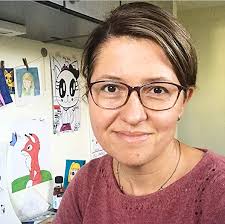 To purchase A WHALE OF A MISTAKE visit Indiebound , The Silver Unicorn Bookstore, or your local independent bookstore. Learn more about Ioana Hobai and her books at http://www.ioanahobai.com/ 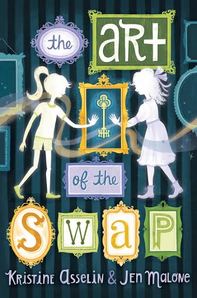 Review by Amanda Smith Hannah Jordan lives in a Gilded Age mansion. Well, actually, she lives in the converted servant’s quarters of a mansion. Her father is the caretaker of The Elms, one of the most esteemed historical properties in Newport, RI. Hannah is a history buff and loves all things antique, but mostly she adores the reproduction portrait of Maggie and longs to spend a day in the rich heiress’ shoes. Maggie is the twelve-year-old niece of the coal tycoon who built The Elms. Even though she loves her aunt and uncle, she finds her life mundane. Portrait sittings, tea with her stuck-up cousin, lawn tennis, and her aunt’s stifling opinions on what girls can and cannot do leave Maggie wanting. In FREAKY FRIDAY-like fashion, Hannah and Maggie swap places though a mirror in the mansion. Hannah, who revels in everything 1905, is set on solving the mystery surrounding the heist of the original Maggie portrait, with the help of kitchen boy, Jonah. Both girls believe solving the heist will switch them back. While Hannah plays investigator and has to swallow archaic beliefs about women, Maggie navigates modern technology, encounters vastly different family relationships, and experiences the liberties and opportunities brought about by the women’s rights movement. In this fun mystery adventure, the reader goes on a time traveling journey with Hannah, and experiences the wonders and restraints of the Gilded Age through the eyes of a modern twelve-year-old. The narrative leads the reader to reflect on today’s privileges and liberties that are often taken for granted. An endearing cast of characters strings readers along multiple twists and turns. They are forced to make difficult decisions and have us rooting for them all the way. Even though THE ART OF THE SWAP (Simon & Schuster/Aladdin; 2018) has two girl main characters, the adventure and mystery aspect, humorous situations, and a strong male character in Jonah make this a story boys and girls will enjoy. The story sheds light on women’s rights and gender inequality. It had both my sons thinking, noticing, and commenting. THE ART OF THE SWAP is an enjoyable book to read aloud with your kids and a perfect classroom book for 5th - 7th grade that will springboard interesting and important discussions. On writing: Hop on over to our blog here to read how Kris and Jen co-wrote THE ART OF THE SWAP. 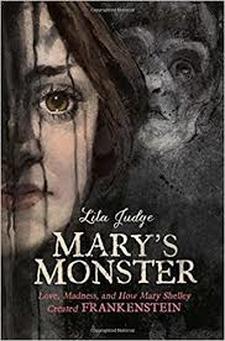 ~ Reviewed by Amanda Smith Mary’s Monster tells the story of a young girl whose loving home is turned into an oppressive prison by a jealous step-mother. After two years’ exile to Scotland, where she finds love and acceptance, she is called back to London to help in her father’s bookstore. Her mundane home life is interrupted when she meets a charismatic poet. The poet, sixteen-year-old Mary, and her younger step-sister run away together and travel through Europe and eventually back to England. Mary experiences beauty, freedom, and life. She sees the destruction of man and war. She meets unbearable challenges, heartache, and abuse. And through it all she fights circumstances, society, and mental illness for the right to live with, and love, her poet. Her struggles and darkest moments lead to the discovery of her own voice and her defining work. Mary’s Monster is the tormenting story of a remarkable young woman. It is also the biography of Mary Shelly, author of the iconic Frankenstein, and wife to poet Percy Bysshe Shelly. Seeped in extensive research, Mary’s Monster leads the reader through the events and places that formed Mary Shelly and gave birth to Frankenstein. Just as Mary Shelly invented the modern science fiction novel, Lita Judge shatters genre boundaries by bringing us a biography that reads like a YA novel, in free -verse, accompanied by magnificent, haunting illustrations. “Like a picture book, it is a dance between words and art, in which each medium takes a turn telling the story and the two become inseparable,” Judge explained. Mary’s Monster would serve as an excellent companion text to any high school student studying Frankenstein, but the book is so much more than a biography and educational tool. It is a stirring story, transporting the reader to a different time, yet carrying themes (such as first love, struggles with parents, and mental health issues) with which most young adults can identify today. On Writing:
Mary’s Monster is masterfully crafted in so many ways. The structure of the book is tight and purposeful, reflecting the multiple points of view of Mary Shelly’s Frankenstein. It is divided into nine parts, echoing the nine months it took Mary to write Frankenstein. Quotes by Percy Bysshe Shelly, Mary Wollstonecraft (Mary Shelly’s mother), and Mary herself introduce each part and lend to the authentic voice of the book. There is a mindfulness in every aspect of this book, including the placement of art. In fact, the amazing interplay between art and text is something never before seen in a biographical novel. The artwork draws the reader in, accentuates the action and emotion in the verses, and adds atmosphere and tone, as well as symbolism. It is just as important a story telling device as the writing. Lita Judge consistently, yet with subtlety, builds on themes central to Mary’s life and her creation of Frankenstein (such as rejection, love, death, women’s rights) throughout the book. With clever foreshadowing and striking word choice, she leads readers through Mary’s journey of self-discovery. However, the most brilliant part of this book, is Judge’s decision to weave direct quotes from Mary Shelly’s journals, and from biographies written about her, into the verse. This is done seamlessly and adds authenticity to the voice (The reader may find the quotations when perusing the back-matter.) Biographies, or the genre that Frankenstein belongs to, might not be every reader’s cup of tea. But the illustrations and human drama of Mary's Monster will compel the biography adverse, non-horror genre reader to grab this book. In doing so, readers will not only learn about Mary Shelly, her life and her challenges, but also about themselves. Mary’s Monster urges readers to reflect deeply on how the world has changed for young women. And the many ways it has not. For more information on Lita Judge, visit her website at https://www.litajudge.net/ To learn more about her process in creating Mary’s Monster, and the significance of the art, read https://www.litajudge.net/mm_timeline/ 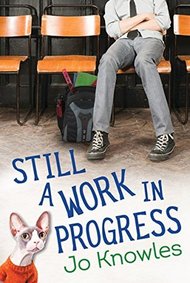 ~by Amanda Smith Noah is a pretty typical middle schooler. He attends a small school where everybody knows everybody’s business, and the biggest news is who’s kissing who behind the storage shed. Yet, in Noah’s family, the Thing That Happened silently rules their household and interactions. As Noah’s sister, Emma, becomes increasingly controlling about food, Noah notices signs that The Thing is happening again, but his parents’ denial and efforts to keep Emma from relapsing cause Noah to suppress his own concerns. He frustration grows as his best friends bicker and fall out over, what seems to Noah, insignificant issues, while his family is unraveling. STILL A WORK IN PROGRESS (2016, Candlewick Press) explores eating disorders and their effect on family members from a sibling’s point of view. Noah’s love and concern for Emma contrasts with his inability to understand why she makes herself sick, and his anger at her for doing so. Knowles illustrates these conflicting emotions in Noah’s response towards Curly, the school cat, who is, like Emma, stressed, frail, vulnerable and adored. With a gentle touch, spots of bright humor, an interesting cast of secondary characters, and a loveable, believable main character, this thoughtful novel will have readers laughing out loud while reaching for the Kleenex. With empathy, Jo Knowles shows us the devastating effect of depression and eating disorders on families, while emphasizing the importance of relationships (with friends, parents, teachers, and pets) in times of crises. On Writing: Jo Knowles has a wonderful ability to reveal character in bite-size bits. When she first introduces a new character, she gives a short description, but builds on that description throughout the novel. This mirrors the little-bits-at-a-time way in which we get to know people in the real world, and results in readers feeling as if they’re gaining a circle of new friends. In STILL A WORK IN PROGRESS, Knowles also employs the animal characters in various ways. They are not just pets, but Curly and Captain offer comic relief, evoke empathy, and drive home points about characters and events in the story. In the same way, food is used throughout the novel to convey emotions, illustrate differences, build tension, amp-up turning points, and reveal aspects of Noah’s character. Using food as a device in a novel about eating disorders is pure Jo Knowles brilliance! To learn more about Jo Knowles and her books, visit her website www.joknowles.com/ In this video clip, Jo talks about the inspiration for the hilarious chapter titles for STILL A WORK IN PROGRESS. 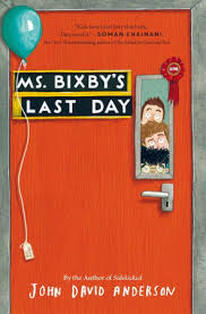 ~ Review by Amanda Smith Some books blink on writers’ radars long before they become common knowledge. These books show up in a plethora of kidlit groups; in Harold Underdown’s posts with comment threads as long as my arm; and on agents’ wish lists. MS. BIXBY’S LAST DAY (2016, Walden Pond Press) is one of those books, and so, when it finally appeared on my library shelf, I expected literary greatness. I expected my need for boxes and boxes of Kleenex. It absolutely exceeded those expectations. What I did not expect was the laugh-out-loud humor. I’m not talking a giggle or a guffaw here. More than once I exasperated my family with outbursts of knee-slapping laughter. John David Anderson’s sharp humor is exactly what this book needed to balance the heart-wrenching story. Ms. Bixby is that one teacher, that if you were really lucky, you had the honor of knowing. A Good One. The teacher who really sees you, the one for whom you want to be your very best, the one who makes even the boring stuff fun. And Ms. Bixby has cancer. In fact, she is so sick that she cannot even make her Last Day party at school. But Brand, one of her sixth graders, still has something important left to say to her. He enlists his friends, Steve and Topher, to help him follow through on his plan to give her the perfect last day, not realizing that both his friends need to see to her as much as he does. Because, just as she saw him, she saw each one of them. Told in three alternating first person narratives, the voices of the three boys, Anderson takes us along on their mission. Snippets of information about each character are carefully unpacked through what these characters show of themselves, and what they know (and don’t know) about their two friends. We get to know their strengths, insecurities, family life and what Ms. Bixby means to each of them, both from the character’s own point of view, and the others’ points of view. We see how they individually, but with the help of their friends, overcome their respective major obstacles, making it possible for them to bid Ms. Bixby goodbye. MS. BIXBY'S LAST DAY left some hilarious images burned in my mind forever – I will never look at cheesecake the same way. It has given my son and me some precious shared quotes like “I was in the basement, eating a body”… “Biscotti”. But more than that, MS. BIXBY'S LAST DAY reminded me to see my children and my students; to recognize everyone has a back story, or a struggle; and to see things through no matter what. On Writing: John David Anderson is masterful at showing instead of telling. He never tells the reader outright what the characters’ struggles are, but he meticulously unfurls each character until the reader has a complete picture of Band, Steve, Topher, Ms. Bixby and the supporting cast. MS. BIXBY'S LAST DAY is also a study in voice. Anderson provides an engaging introduction of each character, their voices so distinct, that at the end of each character’s first paragraph, the reader already has a strong sense of each kid’s personality. “Rebecca Roudabush has cooties, I’m not making this up. We’ve run tests. She came up positive on the cootometer, all red, off the charts.” (Topher, the creative boy with a vivid imagination) “We found out on Tuesday. I was wearing a red sweater. Not bright red. More of a maroon, like the color of cherries – real cherries, not the ones you find in canned fruit that tastes a little like medicine.” (Steve, the detail-oriented, analytical stats-wizard) “You can pick your friends, and you can pick your nose, but you can’t pick your friend’s nose. That’s something my dad told me. Turns out … not entirely true.” (Brand, the rough-around-the-edges tough guy who idolizes his dad.) Don’t you already love these three boys? By the end of the book you will be completely won over, cheering them on to succeed. In true Ms. Bixby fashion. |
Our favorite mentor texts to guide your writing and revisions.
Categories
All
Archives
April 2024
|
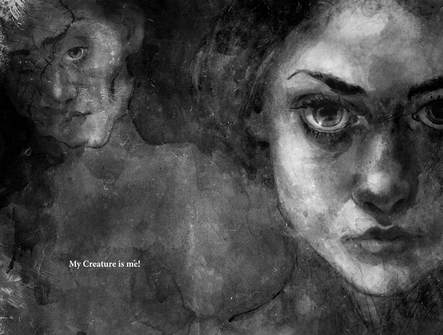
 RSS Feed
RSS Feed